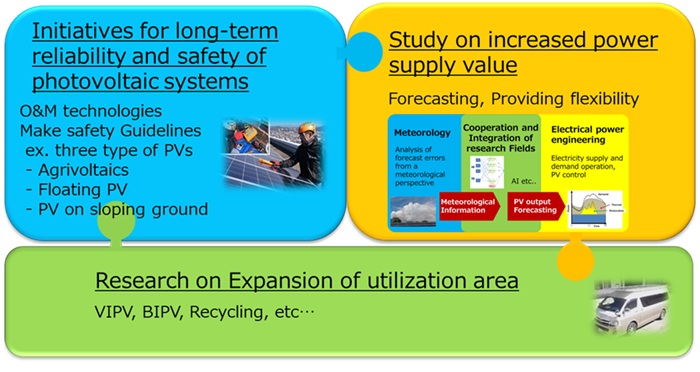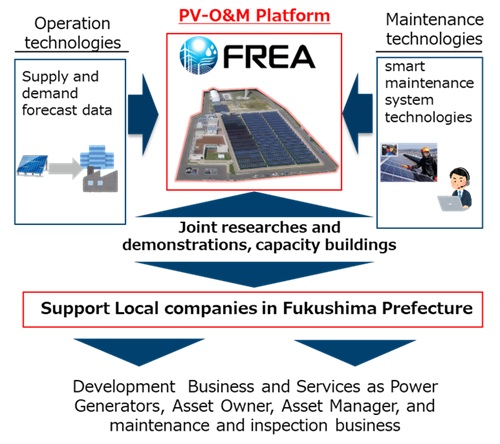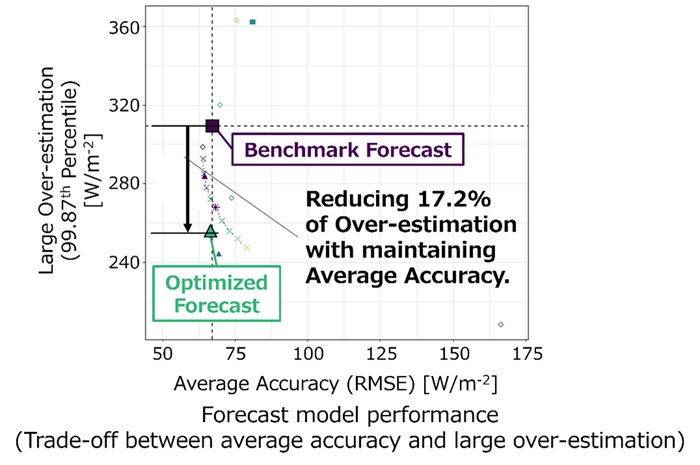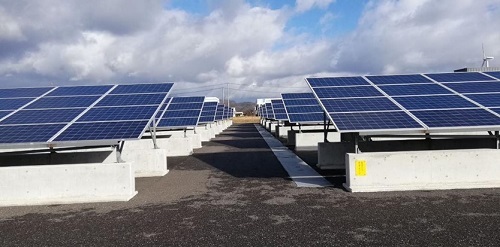Photovoltaic System and Application Research Team
Technologies for Long-Term Stable Power Supply from Photovoltaic systems
Overview
In the 7th Strategic Energy Plan approved by the Cabinet in February 2025, efforts toward making renewable energy a main power source are based on the fundamental principle of S+3E (Safety, Energy Security, Economic Efficiency, and Environmental Compatibility).
The plan emphasizes the thorough implementation of renewable energy as a primary energy source, promoting its maximum introduction while ensuring harmony with local communities and minimizing the public burden.
Achieving long-term stability in energy supply from a photovoltaic system is a key challenge for it to become a core part of the energy infrastructure.
Research Target
Our team is engaged in research and development, as well as foundational work, on design and operational technologies to ensure the safety of solar power generation systems in order to support its role as a main power source.
We are also advancing the development of sophisticated forecasting and control technologies to enable smooth grid integration and the sustainable operation of photovoltaic systems under large-scale deployment.
Furthermore, we are developing system technologies aimed at expanding the application areas of solar power to support its continued growth in the future.

Research Outline
Research and Development on the Long-Term Reliability and Safety of photovoltaic systems
Photovoltaic systems are generally expected to operate for more than 20 years.
However, their most critical components—photovoltaic (PV) modules—are often installed in locations that are not easily visible to users, and they operate silently and without moving parts.
Moreover, since the power output of a PV system is affected by the surrounding environment and constantly changing weather conditions, it is difficult to detect performance degradation or increasing safety risks over its long operational lifespan.
In this sense, PV systems can be considered industrial products that are particularly challenging to monitor and assess over time.
Additionally, during daylight hours, PV modules continue to generate direct current (DC) voltage even when the system is shut down.
This poses a latent risk of electric shock to emergency responders, for example, in the event of a fire in a building equipped with a PV system during the day.
To address these challenges, our team is conducting various investigations and analyses to develop technical and regulatory measures aimed at improving the safety of PV systems.
Research and Development for the Sustainable Operation of PV Systems
A PV system is a power generation technology that directly and instantaneously converts solar energy into electricity without any inherent energy storage capability—essentially making it dependent on weather conditions.
If such PV systems, which have characteristics unlike conventional power generation technologies, are connected to Japan’s power grid in large numbers without proper coordination, the fluctuations in their output may exceed the grid’s ability to absorb them, posing a risk to the stable supply of electricity.
One proposed measure to mitigate this risk is to enhance the energy storage capacity of the power infrastructure. However, such enhancements involve significant costs, and it is ideal to minimize them as much as possible.
Our team is conducting research and development on technologies for monitoring and forecasting PV output using approaches from both natural sciences and engineering, including meteorological observation, weather forecasting, and machine learning.
We are also working on research aimed at enabling PV systems themselves to contribute to upward flexibility capability.

Research and Development on the Expansion of PV System Applications
Further expansion in the deployment of PV systems is essential.
However, this must be achieved through forms of deployment that promote regional coexistence, deliver community benefits, and contribute to a nature-positive future.
To that end, it is necessary to broaden the application areas of PV systems based on technologies that support a sustainable, value-circulating PV system model—one that consistently manages the entire lifecycle of PV systems from planning and installation to decommissioning, disposal, and recycling.
Looking ahead, it will be increasingly important to respond to system diversity and coordinate with land use policies.
Key directions include a return to building-integrated installations, integration with agriculture, contributions to nature-positive outcomes, and applications in mobility sectors.
Post-Disaster Reconstruction and Mainstreaming of PV systems through Collaboration with Companies in Fukushima Prefecture
Through collaboration with companies in Fukushima Prefecture, we aim to support the reconstruction of areas affected by the Great East Japan Earthquake while promoting the transition of solar power into a mainstay energy source.
By fostering local industries through joint efforts in the development of advanced technologies and human resource training for PV system operation and maintenance (O&M), we seek to contribute both to regional revitalization and to the realization of long-term, stable PV systems as a core element of Japan's energy infrastructure.
<Related Information>Formation of a Technical Development and Human Resource Training Hub for Photovoltaic O&M” Project (FY2021–2026).(This page is available only in Japanese.)

Activities and Achievements
Infrastructure Development for the Safety of Solar Power Generation
As part of our efforts to establish foundational infrastructure for the safety of solar power, we have published a range of resources, including technical information on DC electrical safety and fire risk countermeasures for PV systems, on-site maintenance and inspection procedures, reports on near-miss incidents and actual safety events, and design support tools related to snow load in structural design.
For more details, please refer to “Information on PV System Safety.”In Japanese Additionally, to ensure the safety of PV installations, we have conducted demonstration experiments to assess electric shock risk.
These experiments estimate transient shock currents caused by ground capacitance and provide design guidelines, including acceptable limits for the number of parallel-connected modules.
<Related Information>Guidelines and Technical Information for DC Electrical Safety in Photovoltaic systems(This page is available only in Japanese.)
Based on these findings, we are formulating comprehensive design and construction guidelines for various types of PV systems.
For more information, please refer to the NEDO website. In Japanese.
<Related Information>Guidelines for Improving the Reliability and Safety of Photovoltaic Systems(Outbound link *This page is available only in Japanese.)
Development of PV system output Forecasting Technologies Content
We are conducting research and development aimed at reducing large forecast errors in PV system output by leveraging advanced weather forecasting technologies.
The figure below (Fig.4) shows an example of a mesoscale ensemble forecast (meso-ensemble) using multiple meteorological forecast models from both domestic and international sources, applied to a specific power grid area.
Ensemble forecasting has the advantage of representing prediction uncertainty through forecast intervals, allowing us to analyze factors contributing to large forecast errors.
Using this approach, we are investigating methods to enhance the reliability of PV system output forecasts.
Fig.7 illustrates the results of applying a machine learning model that uses meso-ensemble forecasts as input.
The model reduces the frequency of large prediction errors while maintaining average forecast accuracy to a reasonable degree. This research has the potential to improve power system operations in infrastructures with high PV systems, enabling more effective planning and coordination of existing power generation and transmission facilities, and reducing risks to the stable supply of electricity.

Demonstration Experiment of integrated photovoltaic system with Electric Vehicles(PVEV)
Reducing carbon dioxide emissions in the transportation sector is a pressing issue in the effort to realize a carbon-neutral society, and the electrification of vehicles is rapidly advancing.
The combination of vehicle electrification and the integration of photovoltaic (PV) modules is highly compatible with decarbonization goals, and it is expected that equipping vehicles with PV modules will enhance user convenience and improve service quality.
Our team is conducting demonstration experiments to accelerate the social implementation of such integrated photovoltaic system with electric vehicles (PVEVs).
As shown in Fig.5, we have introduced PVEVs developed for commercial use cases such as package delivery and community buses.
We are evaluating the contribution of PV-generated electricity to the total daily energy consumption—referred to as the PV contribution ratio—to determine how much of the required driving energy can be supplied by PV power.

Main Research Facilities
Experimental PV Array Description
This photovoltaic (PV) array is used for various PV systems’ experiments.
It includes bifacial modules and mounting structures designed for vertical installation.

Demonstration PV sysmte Facility Description
The PV systems installed on the FREA premises consist of two configurations: one connected to multiple distributed 10 kW PCS units (shown on the right in Fig.7), and another connected to a centralized 250 kW PCS unit (shown on the left in Fig.7).
Experiments can be conducted under actual power generation conditions. Additionally, it is possible to carry out demonstration experiments equipped with continuous monitoring devices, as well as tests that simulate faults and malfunctions.


Top:Full view, Bottom:Enlarged view of the left side of the top
Team Member
| Title | Name |
|---|---|
| Leader, Team | OOZEKI Takashi |
| Chief Senior Researcher | MIZUNO Hidenori |
| Senior Researcher | KATO Kazuhiko |
| Senior Researcher | TAKASHIMA Takumi |
| Senior Researcher | OHTAKE Hideaki |
| Researcher | TAKAMATSU Takahiro |
| Researcher | BUNME Pawita |
